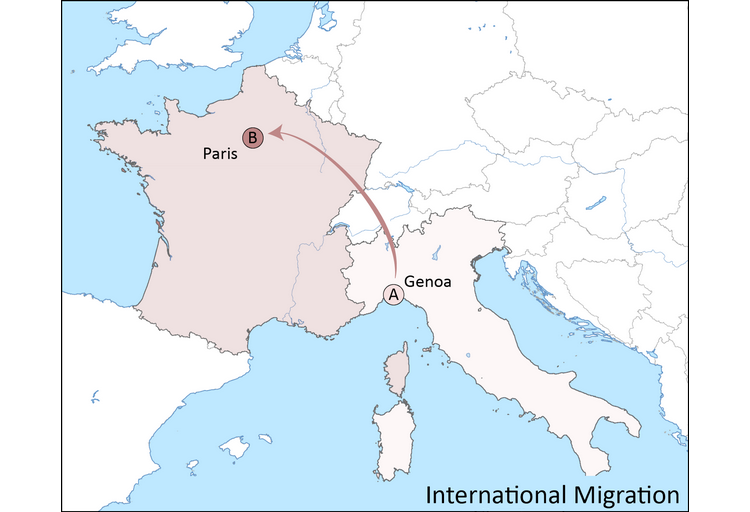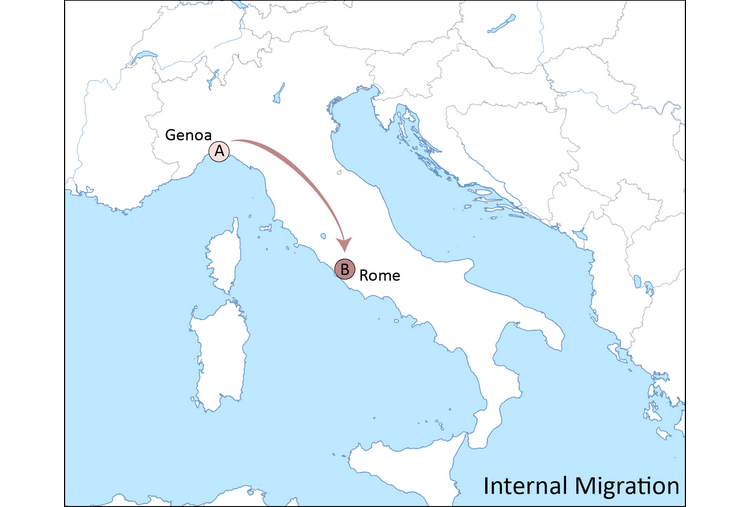While mobility and migration are words that are heard in everyday speech, let's look at these words through a more critical, theoretical lens. These words are intimately intertwined, with mobility informing an individual or a group’s ability to migrate. Thus, migration is considered a subdiscipline of mobility. Here, we’ll work to define them separately, while still paying close attention to their interdependencies.
Mobility
The term mobility has meaning in a variety of different disciplines, not just Geography. Recall Cresswell’s (2006) discussion of the changing viewpoints of mobility as scientists discovered more about the human body. As with much of what we have discussed, a singular, comprehensive definition of mobility is hard to pin down. Merriam-Webster defines mobility as:
“The ability or capacity to move.”
You can see how such a general definition could apply to many different disciplines. While this definition is a good basis for discussion, keep in mind that mobility researchers are not only interested in the ability of people to move, but also in the flow of goods through space and time. Think about the Suez Canal blockage in March of 2021 and what that meant for the movements of goods and how that impacted services globally.
Exercise:
When you think about mobility in your own life, what do you think of? How do you get to work? To school? To the grocery store? What factors play a role in your decision making? What modes of transportation are available to you?
Think about your answers to these questions. Also think about how your answers may differ from those of your classmates. These answers likely have to do with who you are: your identity. What about how they differ from individuals in different geographic areas, say Germany, or Tanzania, or Japan. Kraemer et al. (2020) performed a study taking locational data from Google to ascertain spatio-temporal global mobility patterns, and they found some pretty interesting results when defining “mobility” in terms of distances traveled. One of the findings was that lower income countries tend to travel shorter distances than higher income countries (Kraemer et al., 2020). Cross-border movement is even more interesting, with smaller countries experiencing greater cross border mobility, but also those countries experiencing a variety of different crises, which makes mobility patterns fluid and situation dependent (Kraemer et al., 2020). While this data and research is admittedly skewed to subjects who have access both to smart phones and a mobile network, it is a good quantitative methodology for understanding global mobility. It would be interesting to consider how these global mobility patterns change or stay the same at different scales of analysis.
Mobility considerations obviously have to do with movement--but yet another aspect of mobility is the absence or limitations of movement as well and the factors that play in an individual, group, or material’s immobility. What makes one individual, group, or material more mobile than others? Are they characteristics of the individual, group, or material, characteristics of the landscape, or some combination of the two?
Another aspect of mobility of great interest to mobility researchers is (Can you guess? Hint: It’s a common theme of this course!) scale! As history has progressed, so too has the ability to move about and traverse the land-and water-scapes, changing with it potential geographic scales of mobility of people, goods, and services (Cresswell, 2010). Examples include: walking, biking, horse, boat, train, car, motorcycle, airplanes, and so many more. The modes available may also change with the scale of the unit you’re traveling with: just yourself, your family, a work unit, etc. It may be too expensive for you to travel by air with your entire family, but driving may be a viable option. Thus, one’s (or one’s group’s) mobility may be impacted by other factors.
These are just a fraction of the topics and questions that are of interest to mobility researchers. As the world changes around us, especially in terms of technology and connectivity, so too will the field of mobility change and evolve. What do you think is the future of mobility research?
Migration

As mentioned previously, migration is often considered a subdiscipline of mobility, focused on movement from point A to point B. Let’s look at the Oxford Dictionary of Geography, which defines migration as:
“The movement of people from one place to another.”
That definition checks out, but, like the mobility definition, this definition is another that is very general, where many different meanings can be inferred. One of the critiques of migration research is that it often focuses on origins and destinations, and with little consideration to what occurs in between: modes of travel, the experience of that travel, the route taken, any intermediary stops, conduits, barriers, etc. (Cresswell, 2010). Often this is where mobility research can often step in and fill in the gaps; however, that is not to say that migration research should ignore these important facets of migration, the migration experience, and its impacts on the individual or group experiencing them.
As with mobility, migration can happen at a variety of different scales. You can migrate across town. You can migrate to another state. You can migrate to another country. Maybe one day you can even migrate to another planet! As such, there are several different types of migration that can be defined and studied. Different types include but are not limited to internal migration, international migration, voluntary migration, forced migration, return migration, seasonal migration, and chain migration. We’ll only discuss a few in this section and deep dive more fully into forced migration in the next lesson. Know, however, that these are not representative of the entirety of the different forms of migration.
Here are the definitions for some of the types of migration:
- International Migration:
Moving from one country to a different country (also referred to as immigration). An example of international migration is moving from Genoa in Italy to Paris in France (See Figure 7.2).

- Internal Migration:
Moving within a country, such as moving from Genoa in northern Italy to Rome in central Italy (see Figure 7.3).

- Forced Migration:
The European Commission defines forced migration as movement “in which an element of coercion exists.” This is an incredibly general definition, and thus could encapsulate a variety of different types of movement. This migration could be within a country or to other countries (refugees). These events could be natural or as a result of conflict. An example of forced migration includes the 2010 Haitian earthquake, which left over a million Haitians without housing, forcing these individuals to find homes elsewhere.
- Return Migration:
Movement back to one’s home country or previous place of residence (their “origin” or point “A”). The return may be voluntary or forced. An example of forced return migration may include deportation.
- Seasonal Migration:
Movement from a place of origin for part of the year, usually for employment, and includes a return back to the place of origin upon conclusion. This type of migration is a common agricultural practice.
- Chain Migration:
Movement that is built upon networks, where people or families follow to the destination from the origin (Rush, 2018). In some ways, the initial migrants overcome obstacles (barriers, discussed later) to enable those back at the origin to migrate more easily.
References:
Cresswell, T. (2010). Mobilities I: Catching up. Progress in Human Geography, 35(4), 550-558.
Cresswell, T. (2006). On the move: Mobility in the modern Western world. Routledge.
Kraemer, M. U. G., Sailek, A., Zhang, Q., Marchal, N. A., Tuli, G., Cohn, E. L., Hswen, Y., Perkins, T. A., Smith, D. L. Reiner Jr., R. C., and Brownstein, J. S. (2020). Mapping global variation in human mobility. Nature Human Behavior, 4(8), 800-810.
Rush, N. (2018). Chain migration explained by scholars. Center for Immigration Studies.